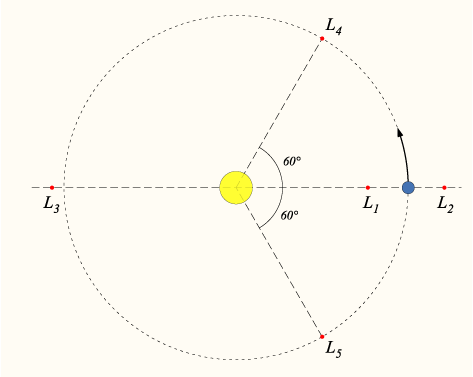System for relaying data back to earth
Since the lunar radio telescope is to be placed on the far side of the moon (in order to obtain good shielding from man-made noise), there is no direct radio contact with earth possible. Hence we need one or multiple additional satellites to be able to communicate with the earth.
Positioning of relay satellites
A very good position for a relay satellite would be if the satellite was stationary at that position with respect to the earth and the moon. In this case we could establish a permanent communications link from moon to the relay satellite and from the relay satellite to earth without having to steer the dish antennas much.
Stationary points
In fact there are several stationary points (called Lagrangian points) for two body orbital systems [2]:

For our relay satellite we are interested in the L2 point since it is reachable from the far side of the moon where our telescope is to be located. The L2 point is located l=61.500km from the moon. Knowing this and some data about earth and moon (see table) we can calculate if it would be possible to send data from L2 to earth or if we need another relay satellite because the moon shields the earth.
| Earth | Moon | |
| radius | 6370km | 3427.2km |
| perigee |
363104km | |
| apogee | 405696km |
Reachability of L2 from Earth
If we calculate the angle φ1 between earth center, L2
and earth pole
we obtain φ1 = atan(re/(x+l)) = 1.719°.
Calculating the angle φ2 between moon, L2 and moon pole
we obtain
φ2 = atan(rm/l) = 6.4702°.
This means that unfortunately the moon completely shields the earth
from radiation from a transmitter at the L2 point. As a consequence we
need another relay satellite to be able to send
data back to earth. Places that are well suited for a second relay
satellite are the L4 and
L5 points.
Stability
The image below (taken from [2]) shows the effective potential for the Sun-Earth system:

The first three Lagrangian points are stable only in the plane
perpendicular to the line between the two bodies which means that they
are nominally unstable. However we can find quasi-periodic Lissajous
orbits around the L2 point
of Earth-Moon that require only moderate effort of station keeping.
In fact the Wilkinson Microwave Anisotropy Probe (WMAP), an ongoing
mission of NASA, uses the L2 point of Sun-Earth and shows that station
keeping can actually be done.
Another possible solution
Another possible approach would be to have just one satellite rotating around the moon. However this would require a huge amount of storage at the radio telescope since half of the time no transmission link to the one and only relay satellite would be possible. Furthermore the transmission of the data would need to take place at twice the original data rate which seems not very feasible given that the original data rate is around 42Gbps.